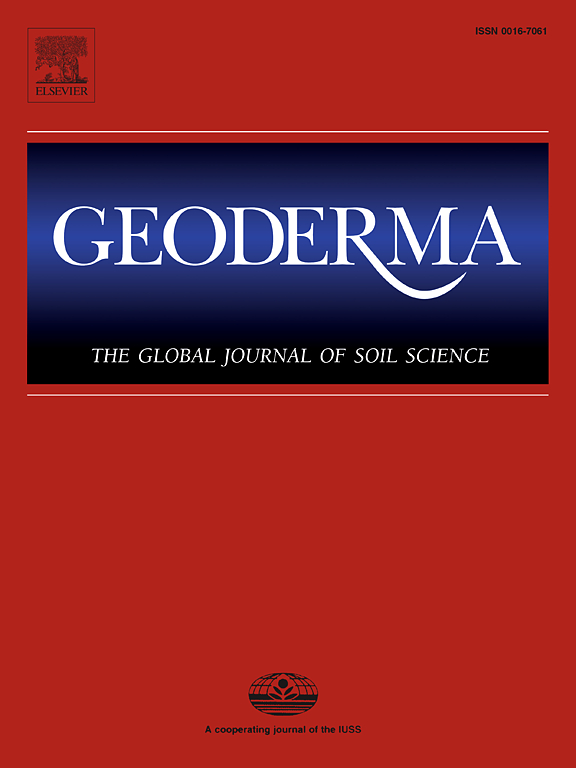热带和温带非火山地区土壤深度的土壤有机碳控制
IF 5.6
1区 农林科学
Q1 SOIL SCIENCE
引用次数: 0
摘要
土壤有机碳(SOC)是气候调节、土壤肥力、生物多样性和健康陆地生态系统的基础。了解关键的控制因子及其途径是估算有机碳分布和预测碳固存潜力的必要条件。以往的研究强调活性Al/Fe(酸-草酸盐可萃取物)对有机碳含量的显著影响,特别是在火山土壤中,但在了解不同土壤深度的有机碳、活性Al/Fe、气候和非火山母质之间的相互作用方面仍然存在空白。在这里,我们使用随机森林回归(RFR)和结构方程模型(SEM)来探索这些动态。我们的分析包括了211个站点(2个深度)表层和底土层的17个soc相关的理化土壤变量和4个气候特征。该研究涵盖了从亚湿润到湿润非火山地区的178个热带和33个温带地区,主要是酸性到中性土壤ph。我们发现,SEMs解释的有机碳差异(表层土54%,底土75%)与RFR结果(表层土61%,底土72%)密切匹配,突出了SEMs在识别关键的有机碳控制因素方面的有效性:年平均温度(MAT)和过量降水(水分指数):降水-潜在蒸散发)表示气候,Al2O3 + Fe2O3(总Al和Fe含量以氧化物表示)表示母质,活性Al/Fe和pH表示土壤性质。RFRs和SEM路径系数的部分依赖表明,MAT、活性Al/Fe和pH直接影响表层土壤有机碳,而活性Al/Fe直接控制底土有机碳。此外,sem表明表层土壤有机碳与活性Al/Fe之间存在双向相互作用,其中活性Al/Fe增加有机碳,反之亦然,而在底土中,活性Al/Fe对有机碳具有实质性的单向控制。重要的是,气候和母质都通过调节活性Al/Fe含量间接影响有机碳,特别是在底土中。这些发现可以通过关注活性Al/Fe、气候和母质在非火山地区不同土壤深度和气气带的直接和间接影响来预测有机碳分布和完善有机碳动态模型。本文章由计算机程序翻译,如有差异,请以英文原文为准。
Controls on soil organic carbon across soil depths in tropical and temperate non-volcanic regions
Soil organic carbon (SOC) is fundamental for climate regulation, soil fertility, biodiversity, and healthy terrestrial ecosystems. Understanding the key controllers and their pathways is required to estimate SOC distribution and predict C sequestration potential. Previous research emphasized the significant impact of active Al/Fe (acid-oxalate extractable) on SOC content, especially in volcanic soils, yet gaps persist in understanding the interactions among SOC, active Al/Fe, climate, and non-volcanic parent materials across different soil depths. Herein, we explore these dynamics using random forest regression (RFR) and structural equation modeling (SEM). Our analysis included 17 SOC-related physicochemical soil variables and 4 climatic properties across topsoil and subsoil horizons at 211 sites (2 depths). The study covers 178 tropical and 33 temperate sites from sub-humid to humid non-volcanic regions, predominantly with acidic to neutral soil pH. We found that SOC variance explained by SEMs (54 % for topsoil, 75 % for subsoil) closely matched RFR outcomes (61 % for topsoil, 72 % for subsoil), highlighting the efficacy of our SEMs in identifying key SOC controllers: mean annual temperature (MAT) and excess precipitation (moisture index: precipitation – potential evapotranspiration) for climate, Al2O3 + Fe2O3 (total Al and Fe contents expressed as oxides) for parent material, and active Al/Fe and pH for soil properties. Partial dependence in RFRs and path coefficients in SEM indicated MAT, active Al/Fe, and pH directly contribute to topsoil SOC, whereas active Al/Fe directly controls SOC in subsoil. Furthermore, SEMs indicated bidirectional interaction between SOC and active Al/Fe in topsoil, where active Al/Fe increased SOC and vice versa, while in subsoil, active Al/Fe has substantial unidirectional control over SOC. Importantly, both climate and parent material indirectly affected SOC by regulating active Al/Fe contents, particularly in subsoil. These findings enable predicting SOC distribution and refining SOC dynamics models by focusing on the direct and indirect impacts of active Al/Fe, climate and parent material across different soil depths and climatic zones in non-volcanic regions.
求助全文
通过发布文献求助,成功后即可免费获取论文全文。
去求助
来源期刊

Geoderma
农林科学-土壤科学
CiteScore
11.80
自引率
6.60%
发文量
597
审稿时长
58 days
期刊介绍:
Geoderma - the global journal of soil science - welcomes authors, readers and soil research from all parts of the world, encourages worldwide soil studies, and embraces all aspects of soil science and its associated pedagogy. The journal particularly welcomes interdisciplinary work focusing on dynamic soil processes and functions across space and time.
 求助内容:
求助内容: 应助结果提醒方式:
应助结果提醒方式:


